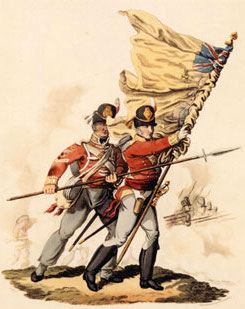|
List Of British Colours Lost In Battle
This is a list of Regulation Colours, British colours lost in battle. Since reforms in 1747 each infantry regiment carried two Military colours, standards and guidons, colours, or flags, to identify it on the battlefield: a king's colour of the union flag and a regimental colour of the same colour as the Facing colour, regiment's facings. The colours were regarded as talismans of the regiment and it was considered a stain on the unit's honour if they were captured. To prevent this, the colours were protected in the field by a colour party of young officers and experienced sergeants, around which the regiment would rally. As the 19th century progressed, regiments found their colour parties became increasingly vulnerable and some chose not to carry them in the field. The loss of two colours at the 1879 Battle of Isandlwana led to parliamentary debates on whether they should still be carried in the field. Heavy casualties among the colour party of the 58th (Rutlandshire) Regiment of ... [...More Info...] [...Related Items...] OR: [Wikipedia] [Google] [Baidu] |
Regulation Colours
The Regulation Colours are the standard colours used in the armed forces of the countries falling under the Commonwealth of Nations. British Armed Forces colours British Armed Forces units usually carry two Regulation Colours: the Regulation King's Colour and Regulation Regimental Colour. These are often referred to as the standard or ensign. Colours are the identifying battle flags carried by military regiments to show where their respective troops should rally in battle. Originally these were 6'6" × 6' in size, though have now been reduced to 3'9" × 3', as regiments no longer carry their colours on the battlefield. British Army Prior to 1743, each infantry regiment of the British Army was responsible for the design and quantity of standards carried, often with each company having its own design. In that year King George II issued a royal warrant to require each regiment to have, as their first colour, the King's colour. It was also to consist of the Union Jack through ... [...More Info...] [...Related Items...] OR: [Wikipedia] [Google] [Baidu] |

